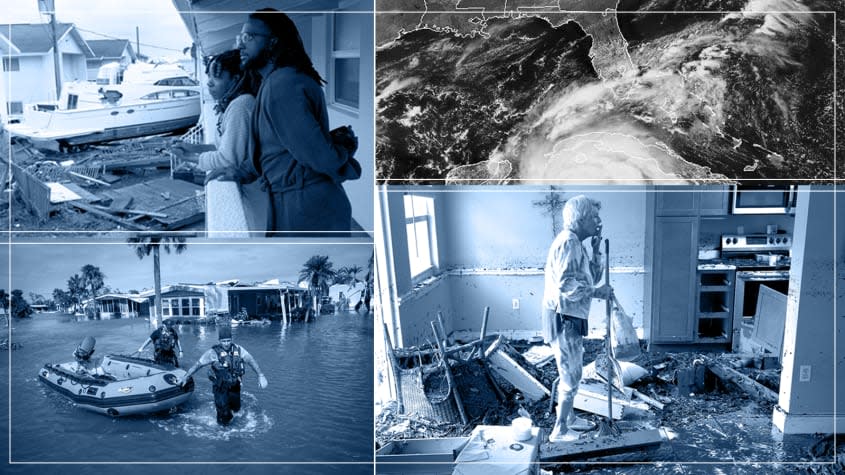How long will it take Florida to recover after Hurricane Ian?

After crashing into Cuba, Hurricane Ian slammed into Florida's southwestern coast on Wednesday afternoon as a Category 4 storm with 150 mph winds. The hurricane caused catastrophic flooding and destruction across the state, decimating homes and businesses in some of Florida's fastest-growing cities, including Fort Myers. Residents are now picking up the pieces and starting the first steps towards rebuilding. Here's everything you need to know:
How destructive was Hurricane Ian in Florida?
Ian barreled into Florida as a powerful Category 4 hurricane, bringing extreme winds, heavy rain, and historic storm surge. Several towns have reported widespread destruction; in the Fort Myers area, piles of debris mark where houses and businesses used to stand, while damaged boats float near mangled docks and downed trees block roadways. Mobile home parks were hit especially hard, as were piers, bridges, and other infrastructure; a section of the Sanibel Causeway fell into the sea, cutting off access to Sanibel Island.
Florida Gov. Ron DeSantis (R) said on Thursday afternoon that search-and-rescue teams, the U.S. Coast Guard, and the National Guard conducted at least 700 rescues of people stranded or otherwise in need of assistance, with most of the operations being by air. As of Friday, the death toll from the hurricane stands at 21.
How long might it take for Florida to recover?
It will likely take several years. While it's clear that Ian caused severe flooding and a life-threatening storm surge, experts say it will take weeks, or even months, to fully measure rainfall and flooding totals and know the extent of the damage. On top of that, insurance adjusters will have to complete their inspections of lost and damaged property. The Orlando Sentinel reports that early estimates by catastrophe risk modelers project the insured losses in Florida, not including National Flood Insurance Program claims, will range from $30 billion to $50 billion.
Will insurance cover everything?
As the Sentinel explains, property insurance "only covers water damage from hurricanes when heavy rains drive the water into a building." When there is a storm surge, and water enters a building from below, that's only covered by flood insurance. In Florida, just 13 percent of homeowners have flood insurance, the Insurance Information Institute says, and those without it will have to pay for repairs themselves. "These people, many of them believe that their homeowners' insurance policy will cover them," Nancy Watkins, principal and consulting actuary at Milliman, told The New York Times. "Or they might think that federal disaster aid is going to swoop in and make them whole."
Is there help for Floridians who don't have insurance?
The Federal Emergency Management Agency (FEMA) does offer emergency grants, but aid is limited to less than $40,000, the Times reports; that's enough to pay for temporary housing in a hotel or cover basic repairs, but not enough to cover the entire loss of a home. Congress has the power to give funding to the Department of Housing and Urban Development for Disaster Recovery grants, which go to states to pay for the rebuilding of homes. This is typically a slow process, the Times says, and it can take several years before residents see any money.
How will this compare to other hurricane recovery efforts?
Since 1851, when record-keeping on hurricanes began in Florida, only 15 Category 4 or 5 hurricanes have hit the state. The National Oceanic and Atmospheric Administration (NOAA) says that 1992's Category 5 Hurricane Andrew was the strongest storm to ever slam into southern Florida. The worst damage was in Homestead, where more than 99 percent of mobile homes were completely destroyed, NOAA said. Andrew caused about $26 billion in damages, having destroyed more than 25,000 homes and damaged 100,000 others. This hurricane changed the landscape in many ways, and not just because it wiped out entire neighborhoods. Many residents decided to move away from Florida rather than rebuild, and the state government passed laws that curbed price gouging and overhauled building codes.
There are some similarities between Ian and 2004's Hurricane Charley — both made landfall in the afternoon near Cayo Costa as Category 4 storms with 150 mph winds. Ian, however, was almost double Charley's size, and moved slower. Charley left 10 people dead in the United States and caused an estimated $6.8 billion in damages in Florida, North Carolina, and South Carolina.
You may also like
5 scathing cartoons about Trump's spiraling legal woes
National Archives says some Trump administration records are still missing

 money
money 